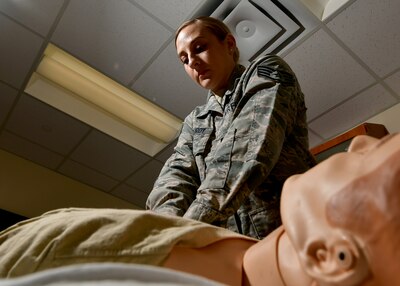By Air Force Staff Sgt. Franklin R. Ramos, 51st Fighter Wing
OSAN AIR BASE, South Korea, Dec. 29, 2017 — After visiting
family in Santa Ana, California, Air Force Staff Sgt. Cassidy McCurdy, an
independent duty medical technician with the 51st Medical Group here, was
heading back to his base on a connecting flight from San Francisco to Seattle,
when things took an unexpected turn.
“I was taking a nap and there was some commotion going on in
the back [of the aircraft],” McCurdy recalled. “Then the [flight attendants]
asked if there was a doctor or emergency medical technician onboard.”
McCurdy sprung to action to assess the situation.
“I got up and there was a woman in cardiac arrest,” McCurdy
said. “There were no other medics around [at the moment] and she didn’t have a
pulse, so I started to do chest compressions. I just completely reacted and did
everything I’ve been trained to do through the emergency medicine protocols
that we do. It was the first time I had to 100-percent rely on myself to know
what to do [in a cardiac arrest situation].”
It took around two minutes of cardiopulmonary resuscitation
for the victim to gain consciousness.
“She quickly gained consciousness. Then another gentleman
moved her to the back where the flight attendants sit,” McCurdy said. “So from
there, we just got her stable [when] she started vomiting and another nurse
came back and assisted.”
Years of Medical Experience
McCurdy has more than five years of experience in the Air
Force’s medical field, including two years as an independent duty medical
technician.
“[As an IDMT] we’re essentially physician extenders trained
on anything in the hospital. We’re able to see patients, prescribe medication,
diagnose and treat them under a flight surgeon,” McCurdy said. “We’re supposed
to be like a mini-hospital ourselves, so if we deploy, we can help take care of
everything like dental, labs, pharmacy, public health and water testing.”
Is there a medic onboard?
McCurdy applied what she learned during her military career
to help aid the victim.
Treating the Patient
“We administered oxygen, maintained her vitals, obtained
glucose readings and made sure she stayed stable,” McCurdy said. “I was able to
do a full neurological exam to rule out a couple of other things.”
Once the aircraft landed, emergency responders from the
ground transported the patient to the emergency room.
“I feel very grateful I was there. She truly was my reason
for being on the plane that night. It has been more than a month since this
happened, and each day I have wondered if what I did was enough and how she is
doing,” McCurdy. “I joined the medical field to help people, so it feels great
knowing that the skillset the Air Force has taught me allowed me to do so in a
moment’s notice.”







No comments:
Post a Comment